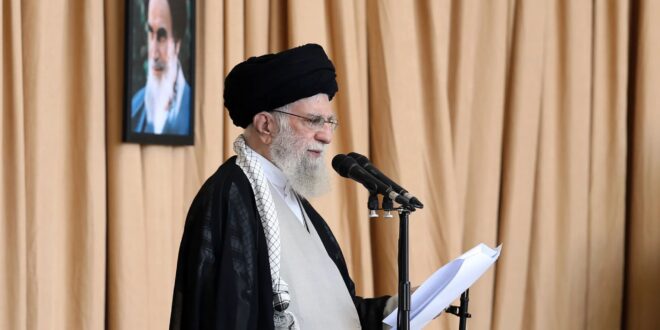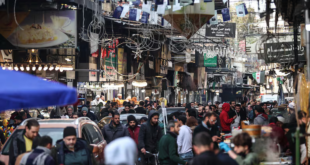The relative failure of Iranian missile strikes has significantly eroded the value of Tehran’s enormous investment in its missile and drone technology and raised serious questions among Iran’s regional allies about the ability of Tehran to come to their defense.
The reverberations of the October 7, 2023 attack on Israel by one of Iran’s allies, Hamas, have undermined the key pillars of Iran’s national security strategy. Although Iranian Supreme Leader Ayatollah Ali Khamenei has vowed to hold to Iran’s long-established course without interruption, Iran’s regional strategy arguably will need to undergo wholesale reevaluation.
The core pillar of Iranian foreign policy and national security strategy has been to fund, arm, train, and advise a network of like-minded regional nonstate actors and governments in an anti-United States and anti-Israel alliance – the “axis of resistance.” Iran has sought to nurture axis members into key decision makers and “king makers” in their countries of origin, able to steer their countries’ policies to support those of Iran. Iranian leaders and strategists have viewed the axis as a means of deterring U.S. aggression against Iran itself by demonstrating an ability to strike anywhere in the region, with effect. Ideologically, the axis has presented Israel with a “ring of fire” that could pressure Israeli leaders to allow the establishment of a Palestinian state or, at maximum, undermine Israelis’ sense of security to the point at which Israel itself is nonviable.
In addition to Hamas, which has entirely controlled Gaza since 2007, Lebanese Hezbollah and the Houthi movement had become, with varying degrees of Iranian help, the leading political movements in Lebanon and Yemen, respectively. Also in the axis are pro-Iranian militias in Iraq that Iran has cultivated since the early days of the 1980-88 Iran-Iraq War as well as allied militias inside Syria. The axis has acted, although not necessarily in full coordination, to attack Israel, U.S. forces in the region, and commercial shipping in the Red Sea in support of Hamas’ battle with Israel in Gaza since the October 7 Hamas attack.
Another pillar of Iranian strategy has been its development and fielding of what the U.S. intelligence community assesses is the largest arsenal of ballistic missiles in the Middle East. Coupled with Iran’s development of advanced Shahed armed drones, Iran’s missile stockpiles were intended to provide additional deterrence by enabling Iran to attack targets throughout the Middle East. Experts assessed Tehran’s arsenal would be able to cause significant destruction in Israel or against other adversaries – particularly as Iran progressively improved the guidance capabilities and accuracy of its projectiles. Iran was also expanding its use of solid fuels, which enable missiles to be rolled out and launched much more quickly than liquid-fueled systems.
Is Israel’s Counteroffensive Transformative?
Since early 2024, Israel’s responses to the Hamas attack and axis of resistance operations in support of Hamas have exposed significant vulnerabilities in Tehran’s strategy. Iran’s missile and armed drone deterrent began to unravel in April, when Iran launched drones and ballistic and cruise missiles at Israel, and Israel, backed by U.S. and Arab partner air defense systems, intercepted the overwhelming majority of them. A similar barrage on October 1 was only modestly more effective in penetrating defenses, landing several missiles at two Israeli airbases, but still causing little material damage and only one casualty (a Palestinian killed by debris from an intercepted missile). Iran has vowed to respond to any Israeli retaliation for the October 1 barrage with an even larger missile launch. However, because Iran’s two missile assaults were relatively ineffective, Iran’s threats did not deter Israeli leaders from preparing a significant retaliatory strike. On October 9, Israeli Defense Minister Yoav Gallant said Israel’s response strike would be “lethal, precise and especially surprising,” and U.S. and Israeli officials are discussing the scope of Israel’s expected retaliation. The relative failure of Iran’s missile strikes has significantly eroded the value of Iran’s enormous investment in its missile and drone technology and raised serious questions among Iran’s regional allies about the ability of Tehran to come to their defense.
Far more perilous for Iran’s national security calculations have been the setbacks its main allies have suffered at the hands of Israel’s offensives since the October 7 Hamas attack. Israel’s ground maneuvers against Hamas in Gaza have not defeated the group but have reduced it largely to an insurgent movement. Hamas can no longer be considered to “govern” Gaza or to pose a major threat to the security of Israelis, although it might retain sufficient capability to prevent attempts by local figures or Palestinian Authority officials to govern the enclave. Similarly, Israeli strikes and ground assaults on Hezbollah have decapitated its command structure and reduced its large arsenal of rockets and ballistic missiles – but have not defeated Hezbollah or rendered it incapable of striking deep into Israel. Hezbollah will likely be able to reconstitute a command structure and reorganize its forces, and it is apparently still strong enough relative to the other major communities in Lebanon to resist efforts to disarm it outright. However, the offensive has weakened the group and potentially paved the way for a cease-fire under which Hezbollah’s elite forces would withdraw to points north of the unofficial Israel-Lebanon border.
In the aggregate, Israeli action has, arguably, largely extinguished Iran’s ring of fire around Israel and deprived Iran of a strategic deterrent against Israeli or U.S. strikes on key Iranian assets. There is ample cause to question whether Iran and its allies can restore their capabilities to the level of threat they posed on the eve of the October 7 Hamas attack. Going forward, Israel is unlikely to allow either Hamas or Hezbollah to rebuild their capabilities to that point. Nor can Iran count on its missile arsenal to deter Israel or the United States.
Will Tehran Change Course?
The setbacks raise the key question whether Iran’s leadership might fundamentally reevaluate the country’s national security strategy and attempts to impose its vision on the region. Khamenei provided an initial answer to that question in his rare October 4 Friday prayer sermon at Tehran University, saying: “Our resistant people in Lebanon and Palestine, all these testimonies and spilled blood will not shake your will, but rather strengthen your steadfastness.” Some experts assert that Iran still views Hezbollah, even if weakened, as the most valuable asset Iran has to project power. Iranian leaders might also assess that Israel’s lack of a “day after” governance and security plan for Gaza will enable Hamas to rebuild its strength as well. And Iran’s threats to launch an overwhelming missile attack at Israeli targets should Israel retaliate for Iran’s October 1 missile assault suggest Tehran views its capabilities as undiminished. Still, it is difficult to see how Iran can reconstitute the pillars of its existing strategy to the point at which Iran would appear as formidable an adversary – either to Israel or the United States – as it did one year ago.
Although Iran’s leaders appear ready to double-down on their existing national security strategy, some Iranian strategists might be counseling a new course. They might argue, as some U.S. and global strategists do, that it is easy to envision scenarios in which Iran’s existing strategy not only continues to fail but also leads directly to a potentially catastrophic direct military confrontation with the United States. It can be argued that an alternative approach, such as sprinting toward acquiring a working nuclear weapon, would only hasten, rather than prevent, major conflict with U.S. forces. Because of the potential for such conflict to lead to the end of the Islamic regime, the supreme leader, throughout his 35 years in power, has always sought to avoid war with the United States.
Should those Iranian insiders who want to alter Iran’s foreign policy prevail, they might argue for a wholesale change in Iran’s outlook toward a less confrontational approach. With no illusions that advocates of a dramatic change in policy will prevail in internal debates, such proposals might include a turn inward toward modernizing Iran’s economy – a focus that would require a dramatic lowering of tensions with the United States and its Western allies. In his address to the United Nations General Assembly in September, newly elected Iranian President Masoud Pezeshkian set the stage for potential changes in Iran’s policies, should the Iranian establishment broadly decide to do so. Saying he was addressing “the American people,” and after repeated long-standing Iranian criticism of the United States, he stated: “In order to build a better future world, Iran stands prepared to foster meaningful economic, social, political, and security partnerships with global powers and its neighbors based on equal footing.”
An inward-looking policy would include turning away from strategic relations with Russia – an alignment that has caused even many European governments to take a harder line against Iran. And, most pointedly, a wholesale policy change would entail working exclusively with the region’s national and U.N.-recognized governments rather than empowering nonstate actors. Even in the context of the wars flowing from the October 7 Hamas attack, Iran has made strides reconciling with Gulf Arab states, suggesting Iranian leaders have seen benefits from policies intended to lower tensions. Still, abandoning the axis of resistance would represent a bitter pill for the supreme leader to swallow – perhaps only exceeded by the “cup of poison” the founder of the Islamic Republic, Grand Ayatollah Ruhollah Khomeini, drank when he accepted the need to settle the long Iran-Iraq War. No expert expects Khamenei to accept or admit failure for a strategy he has relied on for nearly four decades, but doing so might represent the only way to de-escalate an increasingly dangerous confrontation with Israel that could also drag the United States into military conflict with Iran.
 Eurasia Press & News
Eurasia Press & News




